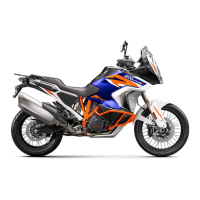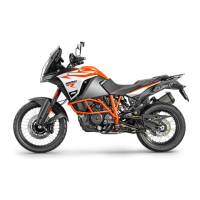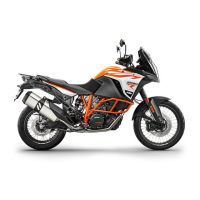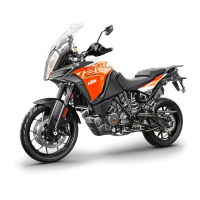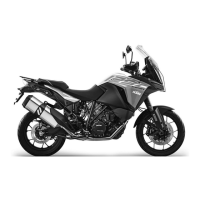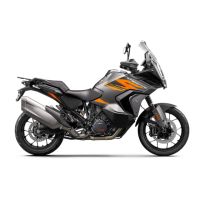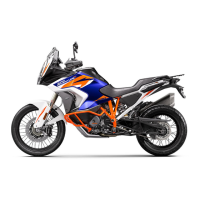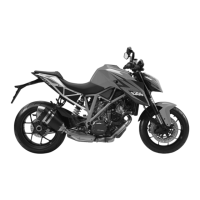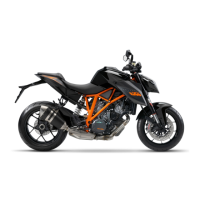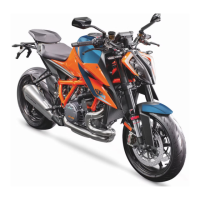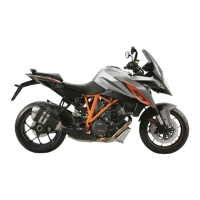Do you have a question about the KTM 1290 Super Adventure S and is the answer not in the manual?
Explains the meaning of various symbols used in the manual.
Explains typographical formats like proprietary names and underlined terms.
Defines the intended purpose and limitations of the vehicle's use.
Describes dangers arising from improper use of the vehicle.
Emphasizes the importance of following safety instructions for safe operation.
Identifies different degrees of danger and associated warning symbols.
Warns against tampering with the noise control system and lists prohibited acts.
Provides essential safety guidelines for operating the motorcycle.
Highlights the importance of wearing appropriate protective clothing for safety.
Outlines general rules and precautions for performing work on the vehicle.
Advises on responsible motorcycle use and fluid disposal.
Stresses the importance of reading the manual for operation, handling, and service.
Details warranty coverage and conditions related to servicing and modifications.
Provides notes on the proper use and environmental hazards of fuel and fluids.
Advises on using KTM-approved parts and accessories for safety.
Explains the importance of proper service for optimal operation and longevity.
Notes that figures may depict special equipment or disassembled components for clarity.
Directs users to authorized KTM dealers for questions and support.
Illustrates and labels key components of the vehicle from the front left view.
Illustrates and labels key components of the vehicle from the rear right view.
Shows the location of the vehicle identification number on the frame and label.
Indicates the location of the type label on the frame.
Explains where to find the key number and its importance for ordering spare keys.
Shows the location where the engine number is stamped on the engine.
Shows the location of the fork part number on the fork stub.
Shows the location of the shock absorber article number on the shock absorber.
Shows where the steering damper article number is embossed on the steering damper.
Describes the location and hydraulic operation of the clutch lever.
Details the location and function of the hand brake lever.
Explains the location of the throttle grip on the handlebar.
Describes the location of the combination switch on the left handlebar.
Explains the function and possible states of the light switch.
Details the operation and possible states of the cruise control system tip switch.
Describes the location and function of the menu buttons on the left combination switch.
Explains the location and possible states of the turn signal switch.
Describes the location and possible states of the horn button.
Describes the location of the combination switch on the right handlebar.
Explains the location and function of the hazard warning flasher switch.
Details the location and possible states of the emergency OFF/starter button.
Explains the function and states of the Race-on button for ignition and steering lock.
Describes how the ignition/steering lock is replaced by a remote key and its operation.
Explains the function of the electronic immobilizer and its activation.
Details the functions of the Race-on key and the black ignition key.
Describes the location and specifications of the electrical accessory socket.
Details the location and specifications of the USB socket for external devices.
Provides instructions and safety warnings for opening the fuel tank filler cap.
Provides instructions and safety warnings for closing the fuel tank filler cap.
Explains the location and operation of the fuel cocks.
Details the procedure for opening the storage compartment.
Details the procedure for closing the storage compartment.
Describes the location of the seat lock and how to unlock it.
Explains the purpose of the grab handles for the passenger.
Describes the location and maximum load capacity of the luggage rack plate.
Explains the location and use of case holders for attaching luggage systems.
Describes the folding mechanism and possible states of the passenger foot pegs.
Shows the location of the shift lever on the engine.
Shows the location of the foot brake lever and its function for the rear brake.
Describes the location and function of the side stand, including its coupling with the starting system.
Mentions the presence of a center stand in addition to the side stand.
Describes the combination instrument, its location, and function areas.
Explains how the combination instrument is activated and its startup test sequence.
Explains the automatic day and night modes of the display based on ambient light.
Explains how warnings are displayed on the screen and their color coding.
Describes the ice warning indicator and the temperature conditions for its activation.
Provides an overview of the various indicator lamps on the combination instrument.
Shows a diagram of the combination instrument display layout with numbered areas.
Explains the speed display and the integrated shift warning light.
Explains the cruise control indicator on the display.
Explains the gear display on the instrument.
Explains the ABS display and its configuration.
Explains the MTC display and its control.
Explains the Heated Grips symbol and its configuration.
Explains the Seat heater symbol and its configuration.
Explains the Damp display and its configuration.
Explains the Load display and its configuration.
Explains the Ride Mode display and its configuration.
Explains the coolant temperature indicator and its possible states.
Explains how the fuel tank contents are shown on the display.
Explains where the ambient air temperature is displayed and how to configure units.
Explains where the time is displayed and how to configure it.
Explains how information items are shown in the Favourites display and how to configure it.
Explains how to open and close the Quick Selector 1 menu and its configuration.
Explains how to open and close the Quick Selector 2 menu and its configuration.
Explains when the Navigation display appears and how it can be configured.
Explains how to open, navigate, and close the main menu.
Explains the conditions and procedure for activating KTM MY RIDE.
Explains the conditions and procedure for using the Audio function.
Explains the conditions and procedure for activating the Navigation function.
Explains the conditions and procedure for setting up navigation options.
Explains how to access navigation information and what it displays.
Explains how to adjust audio volume for navigation and other functions.
Explains how to configure Wireless Interface and Bluetooth via the Setup menu.
Explains the conditions and procedure for pairing devices via Bluetooth.
Explains the conditions and procedure for pairing and using a phone.
Explains the conditions and procedure for pairing a rider headset.
Explains the conditions and procedure for pairing a passenger headset.
Explains the function of Wireless Interface for Bluetooth activation/deactivation.
Explains how to accept/reject calls and adjust volume.
Explains how to access general information within the menu.
Explains the function of Trip 1 for tracking distance, fuel consumption, and speed.
Explains the function of Trip 2, similar to Trip 1.
Explains what information is displayed in General Info, such as date, ODO, battery, and oil temp.
Explains the conditions and procedure for accessing TPMS information.
Explains how to view stored warnings and navigate the Warnings menu.
Explains how to access service information, specifically the next service due.
Lists optional supplementary functions and where to find information on them.
Explains how to configure the vehicle's drive mode in the Motorcycle menu.
Explains how to activate and set the heating level for the heated grips.
Explains how to activate and set heating levels for the rider and passenger seats.
Explains how to select payload settings for suspension adjustment.
Explains the available damping settings for suspension components (SPORT, STREET, COMFORT, OFFROAD).
Explains the available Ride Modes (SPORT, STREET, RAIN, OFFROAD) and their characteristics.
Explains the function of MTC and how it is controlled.
Explains how to switch MTC+MSR on or off.
Explains how to switch ABS off or select between ABS modes.
Explains how to switch the Hill Hold Control (HHC) on or off.
Explains how to configure Favorites and quick selection in the Settings menu.
Explains how to select up to eight items for the Favourites display.
Explains how to select up to four sets of information for the Navi Info Screen.
Explains how to define a menu for direct selection in Quick Selector 1.
Explains how to define a menu for direct selection in Quick Selector 2.
Explains how to configure display settings, units, and various values.
Explains how to make settings for units and various values.
Explains how to activate menu items to confirm the desired unit for distance.
Explains how to activate menu items to confirm the desired unit for temperature.
Explains how to activate menu items to confirm the desired unit for pressure.
Explains how to activate menu items to confirm the desired unit for consumption.
Explains how to activate menu items to select the desired language.
Explains how to switch the shift warning light on/off and set engine speeds.
Provides step-by-step instructions for setting the clock and date.
Explains how to switch the Daytime Running Light (DRL) on or off via the menu.
Explains how to switch the Quickshifter + on or off.
Explains how to switch Heated Grips on or off.
Explains how to switch Heated Seat Rid on or off.
Explains how to switch Heated Seat Pas on or off.
Explains how to perform or switch off the Cornering Light Test.
Provides instructions for lowering and raising the front rider's seat.
Explains handlebar mounting positions and hole distances for adjustment.
Warns about repaired handlebars and advises replacement if damaged or bent.
Explains how to adjust the windshield position using an adjusting wheel.
Details how to adjust the clutch lever position using an adjusting screw.
Details how to adjust the hand brake lever position using an adjusting wheel.
Explains the two possible mounting positions for the rider footrests.
Provides instructions for adjusting the footrest position, including spring tension.
Explains how to check the shift lever position relative to the rider's boot.
Provides instructions for adjusting the shift lever position.
Details how to adjust the shift lever stub position for desired lever length.
Provides instructions for adjusting the foot brake lever position to individual requirements.
Explains how to adjust the tilt of the combination instrument for optimal viewing.
Provides essential advice and warnings before the first use of the motorcycle.
Explains the engine break-in procedure, including maximum engine speeds.
Warns about total weight and axle loads affecting handling characteristics.
Lists pre-ride checks and maintenance measures to ensure roadworthiness.
Provides instructions and safety warnings for starting the engine.
Explains the procedure for starting off from a standstill.
Explains the function of the quickshifter for clutchless up and down shifts.
Explains the Hill Hold Control (HHC) function for preventing rollback on inclines.
Provides advice on gear shifting, load alterations, and passenger safety.
Explains the MSR function for engine control and its conditions.
Provides warnings and advice on brake system maintenance and performance.
Provides warnings and instructions for stopping, parking, and locking the steering.
Gives notes and advice on transporting the motorcycle safely.
Provides instructions and safety warnings for refueling the motorcycle.
Provides additional information regarding service intervals and schedules.
Lists mandatory maintenance tasks and their intervals.
Lists recommended maintenance tasks and their intervals.
Explains the use of semi-active suspension for tuning and adjustment.
Explains how to select payload settings for suspension adjustment.
Explains the available damping settings for suspension components (SPORT, STREET, COMFORT, OFFROAD).
Provides instructions on how to safely raise the vehicle using the center stand.
Provides instructions on how to safely lower the vehicle from the center stand.
Details the procedure for removing the passenger seat using the ignition key.
Details the procedure for mounting the passenger seat, ensuring correct cable routing.
Explains how to remove the front rider's seat by unhooking it.
Details the procedure for mounting the front rider's seat and checking its position.
Explains how to check the chain for dirt accumulation.
Provides instructions and warnings for cleaning the drive chain.
Explains how to check and measure chain tension, warning about incorrect tension.
Provides instructions for adjusting chain tension and warnings about incorrect tension.
Explains how to check for wear on the chain, rear sprocket, and engine sprocket.
Provides instructions and warnings for checking and correcting the hydraulic clutch fluid level.
Explains how to check for play in the steering head bearing and warns about consequences.
Details the procedure for removing the bottom triple clamp cover.
Details the procedure for installing the bottom triple clamp cover.
Explains how to remove the front side cover.
Explains how to install the front side cover.
Details the preparatory work and main steps for removing the mask spoiler.
Details the main steps for installing the mask spoiler.
Explains how to detach brake lines and cables and remove the front fender.
Explains how to position and mount the front fender.
Explains how to clean dust boots and inner fork tubes, warning about dirt accumulation.
Details the procedure for removing the fuel tank cover.
Details the procedure for installing the fuel tank cover.
Explains how to remove the windshield by unscrewing it.
Explains how to position and mount the windshield.
Details the procedure for removing the engine guard.
Details the procedure for installing the engine guard.
Explains the ABS module, sensors, and warnings related to ABS function.
Explains how to check brake disc thickness and for damage, warning about worn discs.
Explains how to check the front brake fluid level and warns about insufficient levels.
Provides instructions and warnings for adding front brake fluid.
Explains how to check the minimum thickness of front brake linings and for damage.
Explains how to check the rear brake fluid level and warns about insufficient levels.
Provides instructions and warnings for adding rear brake fluid.
Explains how to check the minimum thickness of rear brake linings and for damage.
Details the procedure for removing the front wheel, including brake caliper and sensor.
Provides instructions for installing the front wheel, including brake disc cleaning and wheel bearing checks.
Details the procedure for removing the rear wheel, including checking hub damping pieces.
Provides instructions for installing the rear wheel, including brake system checks and bearing inspection.
Explains how to check damping rubber pieces for damage and wear.
Provides warnings and advice on checking tire condition, tread depth, and age.
Explains how to check tire pressure and provides specifications.
Provides warnings and notes on the use of tire repair spray and its potential damage.
Explains the DRL/position light function, its control, and legal regulations.
Explains the cornering light function and the conditions for its activation.
Provides warnings and instructions for safely removing the 12-V battery.
Provides warnings and instructions for safely installing the 12-V battery.
Provides notes on battery discharge, service life, and proper charging procedures.
Provides instructions for replacing the battery in the Race-on key.
Provides warnings and instructions for changing the main fuse.
Provides warnings and instructions for changing fuses in the fuse box.
Explains how to check the headlight beam alignment against a wall.
Provides instructions for adjusting the headlight range using an adjusting wheel.
Explains the location of the diagnostics connector and its use with diagnostic tools.
Describes the installation location and protection of front ACC1 and ACC2 power supplies.
Describes the installation location and protection of rear ACC1 and ACC2 power supplies.
Provides warnings and instructions for checking the coolant level, emphasizing safety.
Provides warnings and instructions for adding coolant and bleeding the cooling system.
Explains the available Ride Modes (SPORT, STREET, RAIN, OFFROAD) and their characteristics.
Explains the function of MTC and how it is controlled.
Provides instructions and information for checking the engine oil level.
Details the procedure for changing engine oil, oil filter, and cleaning oil screens.
Provides instructions and conditions for adding engine oil, emphasizing correct levels.
Provides notes and warnings on cleaning the motorcycle, especially with pressure cleaners.
Provides advice on precautions for aggressive road salt and winter use.
Lists steps for preparing the motorcycle for long-term storage.
Outlines steps for preparing the motorcycle after a period of storage.
Lists faults related to the Race-on button and possible causes/actions.
Provides detailed technical specifications for the engine.
Lists engine component tightening torques for various screws and bolts.
Lists capacities for engine oil, coolant, and fuel.
Provides technical specifications related to the chassis, suspension, and brakes.
Lists specifications for the 12-V battery and Race-on key battery.
Specifies the front and rear tire sizes and models.
Lists specifications for the fork, including article number, spring rate, and oil volume.
Lists specifications for the shock absorber, including article number and spring rate.
Lists chassis component tightening torques for various screws and bolts.
Declares conformity of wireless systems to relevant guidelines with website links.
Lists country-specific declarations of conformity for various systems.
Provides information and links to open source software used in vehicle components.
Specifies standard classification and recommended suppliers for brake fluid.
Provides guidelines for using high-grade, silicate-free coolant with corrosion inhibitor.
Specifies standard classification and recommended supplier for engine oil.
Specifies standard classification and recommended supplier for engine oil.
Specifies standard classification and guidelines for fork oil usage.
Specifies standard classification and guidelines for unleaded super fuel.
Recommends MOTOREX Chain Clean for chain cleaning.
Recommends MOTOREX Fuel Stabilizer as a fuel additive.
Recommends MOTOREX Bike Grease 2000 for long-life lubrication.
Recommends MOTOREX Moto Clean for motorcycle cleaning.
Recommends MOTOREX Moto Shine for paint finishing.
Recommends MOTOREX Moto Protect for preserving paints, metal, and rubber.
Recommends MOTOREX Quick Cleaner for various surfaces.
Recommends MOTOREX Chainlube Road Strong for chain lubrication.
Recommends MOTOREX Joker 440 Synthetic for universal oil spray.
Explains the JASO T903 MA2 standard for motorcycle engine oils.
Explains the SAE viscosity classification system for oils.
Definition of Anti-lock Braking System.
Definition of Automatic Turn Indicator Reset.
Definition of Daytime Running Light.
Definition of Engine Traction Torque Control.
Definition of Hill Hold Control.
System for ignition, steering lock, and fuel tank cap via remote key.
Definition of Motorcycle Stability Control.
Definition of Motorcycle Traction Control.
Definition of On-board Diagnosis.
Engine electronics for shifting up/down without clutch actuation.
Definition of Tire Pressure Monitoring System.
| Engine Type | 2-cylinder, 4-stroke, V 75° |
|---|---|
| Displacement | 1301 cc |
| Transmission | 6-speed |
| Fuel System | Electronic Fuel Injection |
| Dry Weight | 220 kg |
| Front Suspension | WP Semi-active Suspension USD Ø 48 mm |
| Rear Suspension | WP Semi-active Suspension Monoshock |
| Traction Control | Motorcycle Traction Control (MTC) |
| Power | 160 hp |
| Torque | 138 Nm |
| Fuel Capacity | 23 liters |
| Front Brakes | 2 x Brembo 4-piston radial calipers, 320 mm discs |
| Rear Brakes | Brembo 2-piston caliper, 267 mm disc |
| ABS | Bosch 9ME Combined ABS |
| Wheelbase | 1560 mm |

